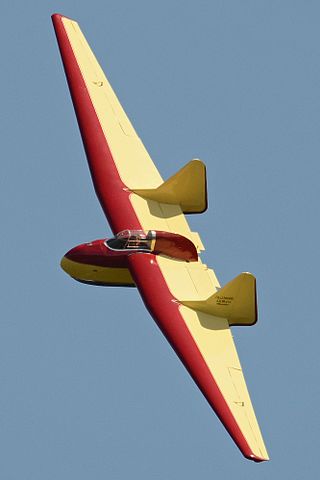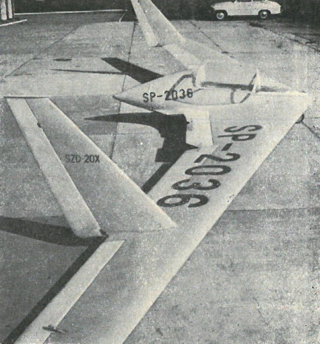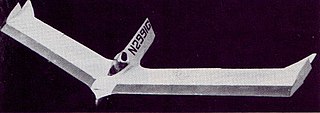
The Aer-Pegaso M-100 was a single-seat glider designed and built in Italy from 1957.

The Antonov A-13 was a Soviet aerobatic sailplane flown in the 1950s and 1960s. It was a small, single-seat, all-metal aircraft developed from the A-11 which could optionally be fitted with that aircraft's longer-span wings. It was a mid-wing monoplane with a tadpole-like fuselage and a V-tail.

The Fauvel AV.36 was a single-seat tailless glider designed in France in the 1950s by Charles Fauvel. Although the "AV" in AV.36 stands for Aile Volante, it was not a true flying wing: it featured two large fins mounted on stubby tailbooms extending back from the wing's trailing edge, and accommodated the pilot within a stubby fuselage. The aircraft was designed to be quickly disassembled for road transport, with the nose detaching, and the fins able to fold back against the trailing edge of the wing. A refined version with a slightly longer wingspan, the AV.361 was introduced in 1960.
The Schneider ES-59 Arrow is a sailplane designed and manufactured in Adelaide, South Australia in the early 1960s. The Arrow was manufactured with a one-piece wing of 13.23 metres span. It was the first Australian-built sailplane to compete in the World Gliding Championships, 1963 in Argentina. The Arrow has wood/fabric wings and tail and a wood fuselage. It has a fixed main wheel and a nose skid.

The PIK-5 was a training glider produced in Finland in the 1940s, and 1950s, equipping the country's gliding clubs with an aircraft greater in performance than primary gliders but less than competition sailplanes.

The SZD-6x Nietoperz was a single-seat tail-less experimental glider aircraft that was designed and built in Poland at Szybowcowy Zakład Doświadczalny in Bielsko-Biała in 1951. Only one example was constructed.

The SZD-20x Wampir II was a single-seat tail-less research glider designed and built in Poland from 1959.

The SZD-22 Mucha Standard was a single-seat aerobatic glider designed and built in Poland from 1957.

The Standard Austria was a single-seat aerobatic glider that was originally designed and built in Austria from 1959 but production was moved in 1962 to Schempp-Hirth in Germany.

The IS-4 Jastrząb was a single-seat aerobatic glider designed and built in Poland from 1949.

The Slingsby T.30 Prefect is a 1948 British modernisation of the 1932 single-seat Grunau Baby glider. About 53 were built for civil and military training purposes.

The Slingsby Type 45 Swallow was designed as a club sailplane of reasonable performance and price. One of the most successful of Slingsby's gliders in sales terms, over 100 had been built when production was ended by a 1968 factory fire.
The Vogt Lo-150 is a West German high-wing, single seat glider that was designed by Alfred Vogt and produced by the Wolf Hirth Company.

The Lehtovaara PIK-16 Vasama is a Finnish mid-wing, single-seat, FAI Standard Class glider that was designed by Tuomo Tervo, Jorma Jalkanen and Kurt Hedstrom, who were students at the Polyteknikkojen Ilmailukerho (PIK) and produced by Lehtovaara.

The Brochocki BKB-1 was a Canadian mid-wing, single-seat, experimental tailless glider that was designed and constructed by Stefan Brochocki with assistance from Witold Kasper and A. Bodek. The designation indicated the contributions of all three men. The aircraft was intended to study flight above the stall angle.

The Wassmer WA-30 Bijave is a French two-seat advanced training glider designed and built by Wassmer Aviation of Issoire.
The Horikawa H-23B-2 is a two-seat training glider designed and built in Japan in the 1950s. It was produced in small numbers.
The Kometa-Standard was a Standard Class glider, designed and built in Bulgaria in the early 1960s. Thirty were flown by local gliding clubs.

The Antonov A-11 is a single-seat, high performance, all-metal sailplane built in the Soviet Union in the late 1950s. 150 were produced.
The IS-4 was a high performance glider designed by Iosif Şilimon and built in Romania in the late 1950s at the URMV-3 factory at Braşov.















